Women of the Welfare Landscape
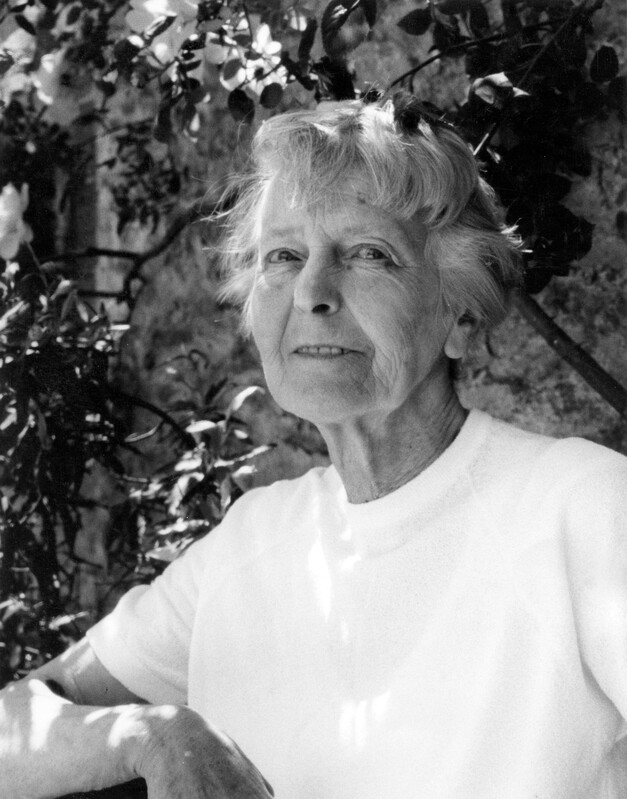
One hundred years ago, in 1922, before gaining the right to vote, 25-year-old Brenda Colvin decided to start her own independent garden design business. Her practice – today Colvin & Moggridge – is the longest-running landscape firm in the country. Once described as ‘wildly eccentric’ and run by a ‘Polish Countess who needed to live in a constant state of high-drama’, Colvin’s office has been at the forefront of finding new ways of working to preserve our landscapes and to tackle what we call today the climate and biodiversity emergency.
This exhibition aims to give a flavour of the variety of projects they designed between the start of the business in 1922 and Colvin’s death in 1981. Selecting a limited number of examples from a hugely rich and varied portfolio is never easy. Our curatorial principle was to show the variety of typologies and scales, to show how Colvin’s practice can exemplify the changing profile of the profession of landscape architecture in the post-Second World War period, and to show designs that prove the continuity of ideas and working principles in her collaboration with Hal Moggridge and the practice’s history.
The decades between the foundation of the practice and Colvin’s death have seen fundamental changes not just in the legal context of planning and landscape architecture, but also the way women participated in a variety of professions and in society in general. They played a crucial role in the development of landscape architecture, and Colvin was a prominent leader of this development as a designer, campaigner, author, educator and driving force in the Institute of Landscape Architects (today the Landscape Institute).
As Hal Moggridge, Brenda Colvin’s business partner from 1969, asserted, ‘landscape design is a co-operative undertaking’. This collaborative nature of the profession sometimes leads to one – or more – of the partners being overlooked in historical accounts. But landscape architecture is arguably also much broader than just design. Policy, theory, and education all play a key role in the creation of successful landscapes, and actors in these areas are also often ‘not-seen’, due to a focus on the designs and built projects.
While showcasing the many aspects of Colvin’s landscape projects, we also aimed to introduce other female professionals with whom she collaborated and whose achievements have so far been overlooked. As with the selection of projects that are represented here, we could only include a small selection of these remarkable individuals, but the guiding principle was the same: showing the different faces of female praxis in landscape architecture and its crucial contribution to the profession.
This exhibition is part of the Women of the Welfare Landscape project, supported by the Arts and Humanities Research Council. During the project we aim to delve deeper into some of the questions discussed in this exhibition. We hope to understand the legacy of landscape architecture in the post-Second World War period, and the contribution women made to it. We would welcome any comments, information, memories, or images you might have. Please do get in touch with us via email at merl@reading.ac.uk – we would love to hear from you!

Brenda Colvin, A Life in Landscape
Brenda Colvin was born in Sima (now Shimla), India, where her father worked in the Indian Civil Service. She was drawn to art and horticulture from a young age.
In 1922 Colvin started her own independent practice, whilst also giving visiting lectures on garden appreciation and advocating for periods in practice for aspiring landscape architects. Her practice quickly grew, and within a decade Colvin was exhibiting her designs at the Chelsea Flower Show, and she was one of the founding members of the Institute of Landscape Architects in 1929.
Colvin was a vanguard of a new kind of landscape architect who sought to engage with the rapidly changing and developing world. Her innovative engagement with the landscape architecture of roads, power, universities, housing, reservoirs and large-scale tree planting led her and her contemporaries to set the standard for sensitive industrial and institutional design.
Colvin was the first woman to be elected president of any leading built environment institute, when she took on the role of President of the Institute of Landscape Architects in 1951. Her work not only defined the future of the Institute – and the profession – but also had lasting impact on the education of landscape architects.
To find out more about Brenda Colvin and Women in the Welfare Landscape, click here.
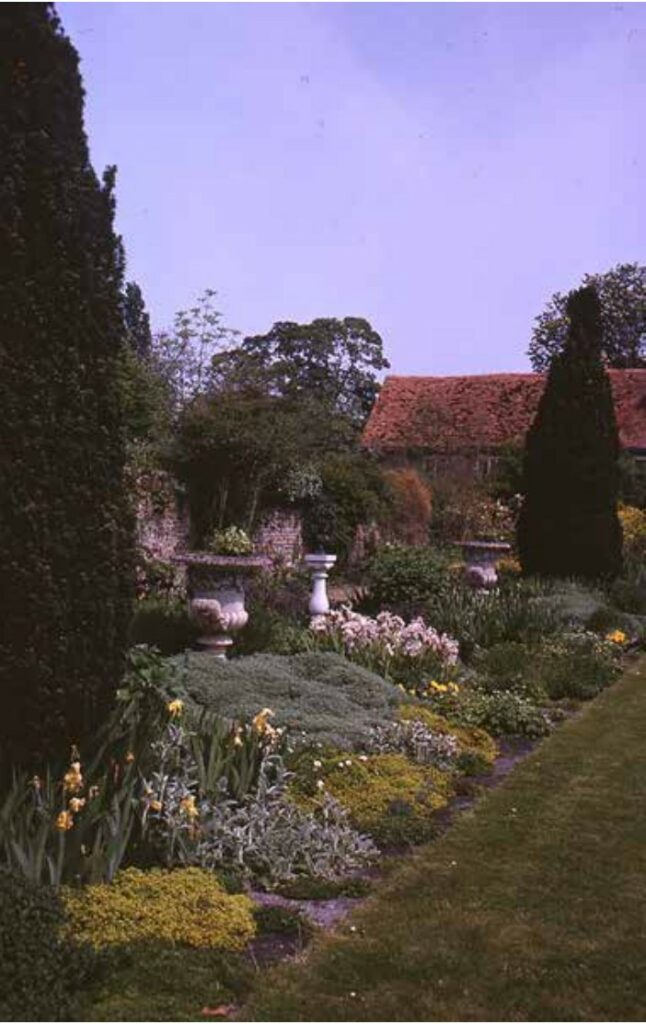
Parks and Gardens
Landscape architecture is often said to had been being more open to women because of its roots in garden design and women’s prominent role in the evolution of designing the domestic sphere. A long lineage of female garden designers such as Gertrude Jekyll and Norah Lindsay paved the way for women looking for an independent career in the first half of the 20th century.
Until the end of the Second World War, Brenda Colvin’s portfolio of work was predominantly garden designs for private clients, and despite the increasing number of large-scale commissions, she continued to take on garden design commissions throughout her career. Her private and public garden projects covered all different scales and included designs for Queen Elizabeth Gardens in Salisbury, Salisbury Crematorium, the CEGB Headquarters, David Astor’s gardens at Elm Tree Road and Sutton Courtenay, and her own garden, Little Peacocks, in Filkins, Gloucestershire, as well as the now lost Seething Lane Garden in the City of London.
The skills that she developed as a garden designer were integral to the success of her public schemes, creating gardens and landscapes for all.
To find out more about the park and garden designs of Brenda Colvin and other notable women Landscape Architects, click here.

Generating Power
In 1947, electricity generation and provision in Britain was nationalised and a decade later, the Central Electricity Generating Board (CEGB) was established through the 1957 Electricity Act. This Act regulated the activities of the Board and included a so-called ‘Amenity Clause’, that defined its dual statutory duties. Firstly, to develop and maintain an efficient, coordinated and economical system of electricity supply, and secondly to consider any effect which their proposals would have on the natural beauty of the countryside and on the flora and fauna. The Board put huge emphasis on the creation of landscapes around their power stations, both coal-fired and nuclear, to fulfil its duties towards the public.
Brenda Colvin became a foremost authority in the design of coal-fired power station landscapes. Her approach led to the creation of complex, multifunctional spaces that satisfied not just the needs of the power industry, but also the communities who lived and worked around them, by creating spaces for leisure, education and amenity.
To find out more about how Brenda Colvin and other women Landscape Architects designed landscapes around sources of power generation, click here.
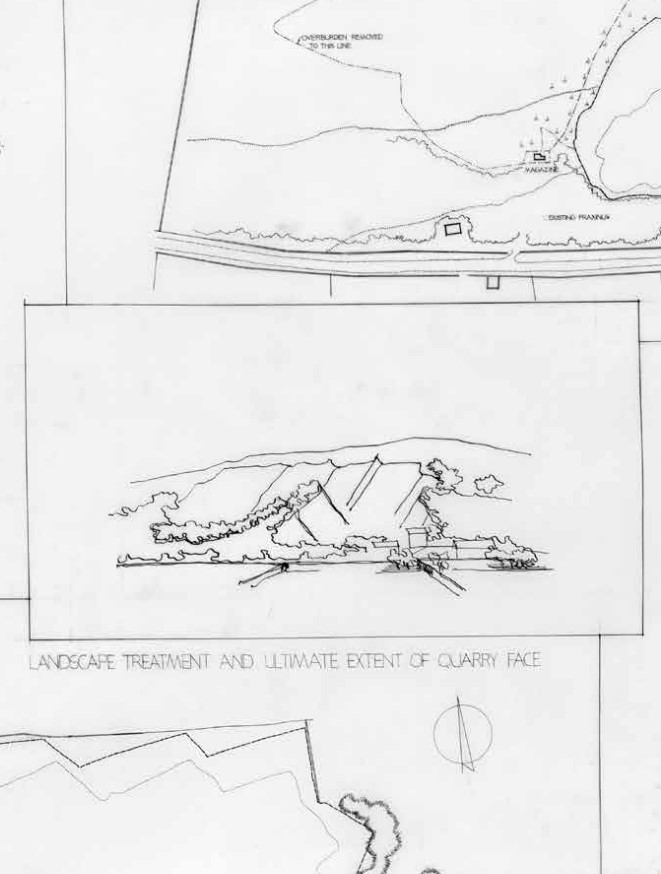
Quarries
Mining, quarrying and other extractive industries have been key in the British economy, and a key question of the post-war period was the reconstruction of the disused sites. As the Duke of Edinburgh wrote: ‘there is no better illustration of the dilemma between conservation and the demands of an industrial urban society than the situation of the extractive industries. We need the resources, but we are naturally anxious about the damage done in their extraction.’
In the post-war period ministerial consent to quarrying was dependent on satisfactory landscape plan that included a long-term design for the site. The first of these types of plans was created for Hope Cement works in the Peak District designed by Sir Geoffrey Jellicoe.
To find out more about how Colvin and other women Landscape Architects helped to heal the damage caused by mining and quarrying, click here.
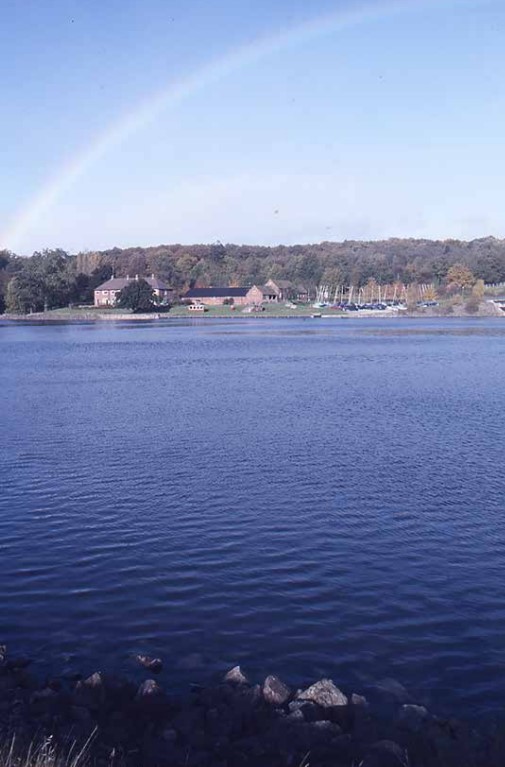
Reservoirs
Reservoirs have been changing the landscapes of Britain since the early part of the 19th century, with an accelerating demand for water and water infrastructure in the 20th century. By the end of the Second World War, a number of companies – over 1,000 in England and Wales, and an additional 210 in Scotland – were involved in providing water. Legislation, such as the 1945 Water Act in England and Wales, the 1946 Water (Scotland) Act and later the 1963 Water Resources Act in England and Wales, created a centralised system of Regional Water Boards and Water Authorities (13 in Scotland and 10 in England and Wales) responsible for supplying water and developing new resources. With similarities to the 1957 Electricity Act, the 1973 Water Act also created a duty to promote ‘amenity’ by the Regional Water Authorities, and landscape architects became key part of the design teams for reservoirs.
To find out more about how Colvin and other women Landscape Architects helped to shape the landscape around reservoirs, click here.
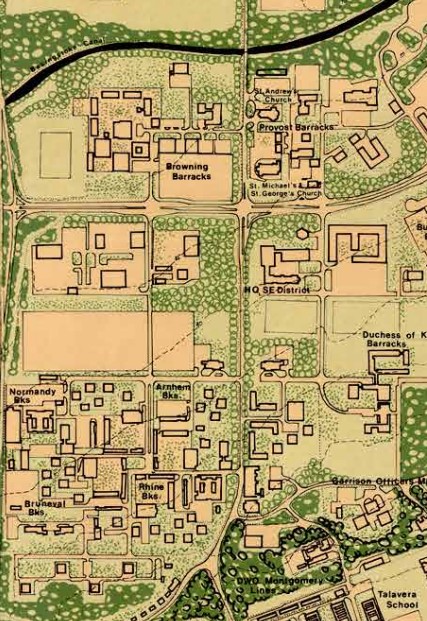
Residential Landscapes
Housing was a priority across peacetime Britain, rebuilding homes that had been lost whilst also delivering a new residential programme through the 1946 New Towns Act and the 1952 Town Development Act. The new towns built upon the garden city model which had led to the creation of Letchworth and Welwyn, as well as creating a new mechanism which removed the provision of large-scale housing from local authorities and placed it in the care of development corporations.
The ILA had been consulted by Lord Reith’s New Towns Committee in 1946, ensuring that landscape architects had a critical role in the planning of new towns. Key to the endeavour was the importance of the ‘landscape treatment’. The principles that the ILA put forward as evidence to the New Towns Committee highlighted the importance of trees, soil, and climate, as well as situating any new habitation within both an agricultural belt and a green belt.
New Town Development Corporations and local authorities gave women many opportunities to work as landscape architects and consultants – Jane Wood, Mary Mitchell and Sheila Haywood all contributed to various new towns and housing estates. Brenda Colvin was engaged as landscape consultant for East Kilbride, while Sylvia Crowe worked on several new towns including Harlow, Basildon, and Warrington.
To find out more about how Colvin and other women Landscape Architects were pivotal to the New Town Movement, click here.
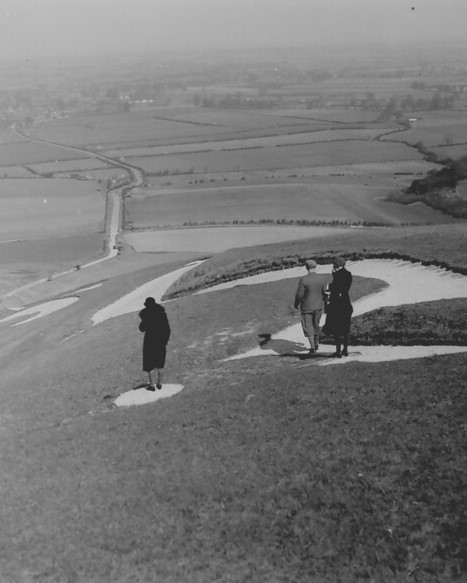
Rural Recreation
Recreational patterns changed after the end of the Second World War, as increased car ownership and leisure time coupled with reduced working time led to a growing demand on access to the countryside. Charities such as the National Trust aimed to ‘promote the permanent preservation for the benefit of the Nation of lands and tenements (including buildings) of beauty or historic interest’, whilst associations such as the Youth Hostel Association or the Ramblers Association aimed to facilitate and advocate for open-air leisure and the right to visit the countryside.
The 1949 National Parks and Access to the Countryside Act and later the 1968 Countryside Act defined a legal framework to confer powers to local authorities and conservation bodies to create sufficient spaces for rural recreation.
To find out more about how Colvin and other women Landscape Architects used their skills to create and restore beautiful areas for recreation, click here.
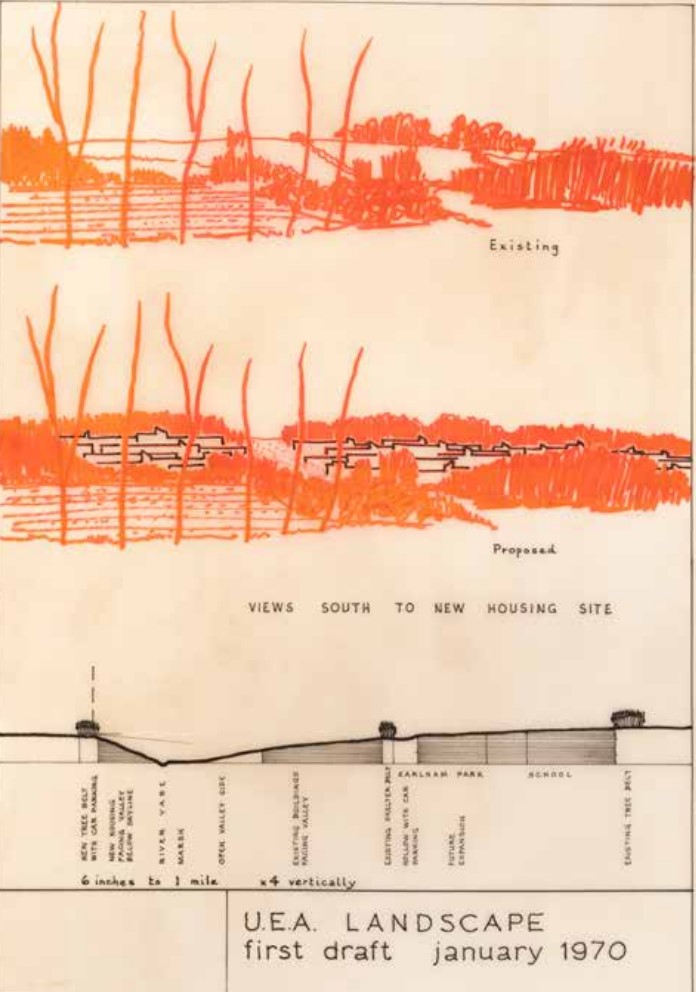
Universities
The end of the Second World War saw an expansion of universities in the UK, building upon the creation of ‘redbrick’ universities at the beginning of the twentieth century. Deriving from the 1944 Butler Education Act and the 1946 Barlow Report, the extension of university education became Government policy. Higher education grew significantly in the 1960s, and new institutions were created parallel to the expansion of existing institutions, supported by significant government funding from 1962.
Colvin worked directly on four campuses, including Trinity College, Oxford, Queen’s University, Belfast, Aberystwyth University – all of which were pre-war universities – and the University of East Anglia in Norwich which was one of the new generation of post-war ‘plate-glass’ universities. In each incidence and at varying scales, Colvin created gardens and landscapes that provided delightful environments in which to learn and relax. The first university that Colvin worked on was Trinity College, with a focus on the area around the chapel and the president’s house and taking in buildings and gardens that were up to 400-years-old and which had evolved from a monastic grove to a formal garden in the 18th century.
To find out more about how Colvin and other women Landscape Architects designed and re-designed university campuses, click here.